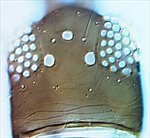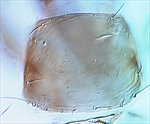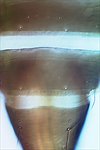Generic diagnosis
Female macropterous. Head as long as wide, projecting slightly in front of large eyes, mouth cone large; maxillary palps 2- or 3-segmented; ocellar setae I present; setae III well developed; eyes with five pigmented facets; four pairs of postocular setae, one pair displaced to posterior. Antennae 8-segmented (rarely 7); segment I with paired dorso-apical setae (or only one such seta); sense cones on III and IV simple (rarely forked); III–VI with few microtrichia on both surfaces. Pronotum with two pairs of long posteroangular setae; three or four pairs of posteromarginal setae. Mesonotum with median pair of setae distant from posterior margin; anteromedian campaniform sensilla absent. Metanotum reticulate medially; median pair of setae at anterior margin; campaniform sensilla absent. Fore wing first vein with long gap in setal row, two setae near apex; second vein with complete row of setae; clavus with four or five veinal and one discal setae; posteromarginal fringe cilia wavy. Prosternal ferna not divided; basantra membranous, without setae; prospinasternum slender and transverse. Mesosternum with sternopleural sutures complete; mesosternal and metasternal endofurca without spinula. Tarsi 2-segmented. Tergites II–VIII with broad craspedum, no ctenidia; setae S1 small and wide apart, campaniform sensilla close to posterior margin; segment IX large, anterior campaniform sensilla present, MD setae slender; X with complete split. Sternites II–VII each with three pairs of marginal setae, all arising at margin.
Male micropterous, sternites without pore plates.
Biological data
All of the species breed on grass leaves.
Distribution data
One of the species in this genus is from North America, but the others are all from various warm areas of the Old World. One species is described from southern China. However, the report from China of the European species dimorphus is possibly a misidentification.
Nomenclatural data
Bregmatothrips Hood, 1912: 66. Type species Bregmatothrips venustus Hood, 1912, by original designation.
Eleven species are listed in this genus (ThripsWiki, 2020), of which two are recorded from China:
dimorphus (Priesner, 1919: 89). (Oxythrips)
sinensis Wang & Tong, 2016: 254.
Relationship data
Thripidae sub-family Thripinae: this is a diverse group involving more than 230 genera. Bregmatothrips is unusual in that all of the species have tergal craspeda, and the tergal campaniform sensilla are unusually close to the tergal posterior margin. Moreover, there is variation among the species in the number of antennal segments, the form of the antennal sense cones (Mound, 2011), and the dorso-apical setae on the first antennal segment. One species, venustus Hood, is widespread around the world and has only one such seta, but this species has been confused with dimorphus particularly in Africa.
References
Mound LA (2011) Grass-dependent Thysanoptera of the family Thripidae from Australia. Zootaxa 3064: 1–40.
ThripsWiki (2020) ThripsWiki - providing information on the World's thrips. <http://thrips.info/wiki/Main_Page>



